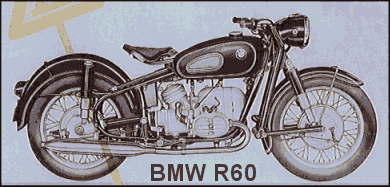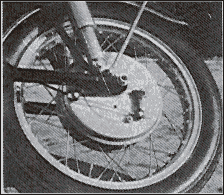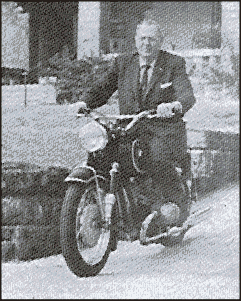
The Earles Fork BMW R60
was manufactured 1955-1969
 The Earles Fork BMW R60 was manufactured 1955-1969 |
| The model furnished was an BMW R60, 600cc, with opposed twin OHV engine and was just out of the crate--only eight miles on the odometer--when delivered to the CYCLE staff by its Western distributor, Earl Flanders of Pasadena, California. After a short briefing on starting technique by Mr. Flanders, the R60 always was a "first kick starter" even during the chilly Pasadena December mornings! The BMW R60 engine features high torque at low RPM and comparatively low compression ratio. It is specifically designed for sidecar work. Nevertheless, this machine can also be considered a tough and absolutely reliable "90-plus" solo mount. Both brakes have full width and finned drums. The front one is equipped with twin cam operated shoes, which accounts for a maximum of braking efficiency with a minimum of pressure applied on the lever. The leverage arrangement of the rear brake also provides an almost effortless operation. All these details, plus a braking area of 28.2 square inches are the BMWs reply to the ever-increasing safety requirements of today's traffic conditions. |  The two levers, operating one independent cam each, are easily seen in the picture above. The result: two leading shoes in the front brake and extraordinary braking efficiency. |
| The gas tank
tap has a reserve position which allows for some 18 miles of extra
riding. An anti theft device locks the steering head completely to the
right hand position. A good part of the road test was performed using
the BMW R60 by daylight and at dark, as a ride-to-work machine, and
also some weekend trips were carried on. Night riding was simple and
safe thanks to the perfect illumination furnished by the BMW lighting
system and its 8-amp-hour battery. Due to the engine's tightness, no maximum speed runs were attempted. However the behavior of the BMW under normal road or freeway riding didn't impress the tester as a slow mount by any means! Furthermore, great care had to be exerted to maintain the speed under legal limits. Acceleration, though not startling, was more than adequate for all practical purposes and the power came in smoothly all the way up the four gear ranges. Steering and road holding ability were well above any stock machine on the market today and if any comparison is to be drawn, it might be necessary to mention some racing thoroughbreds. These features, coupled with wonderful fade proof brakes, turned dense traffic riding into sheer pleasure. A speed of 18.5 mph was perfectly feasible in top gear without any lugging. |
 |